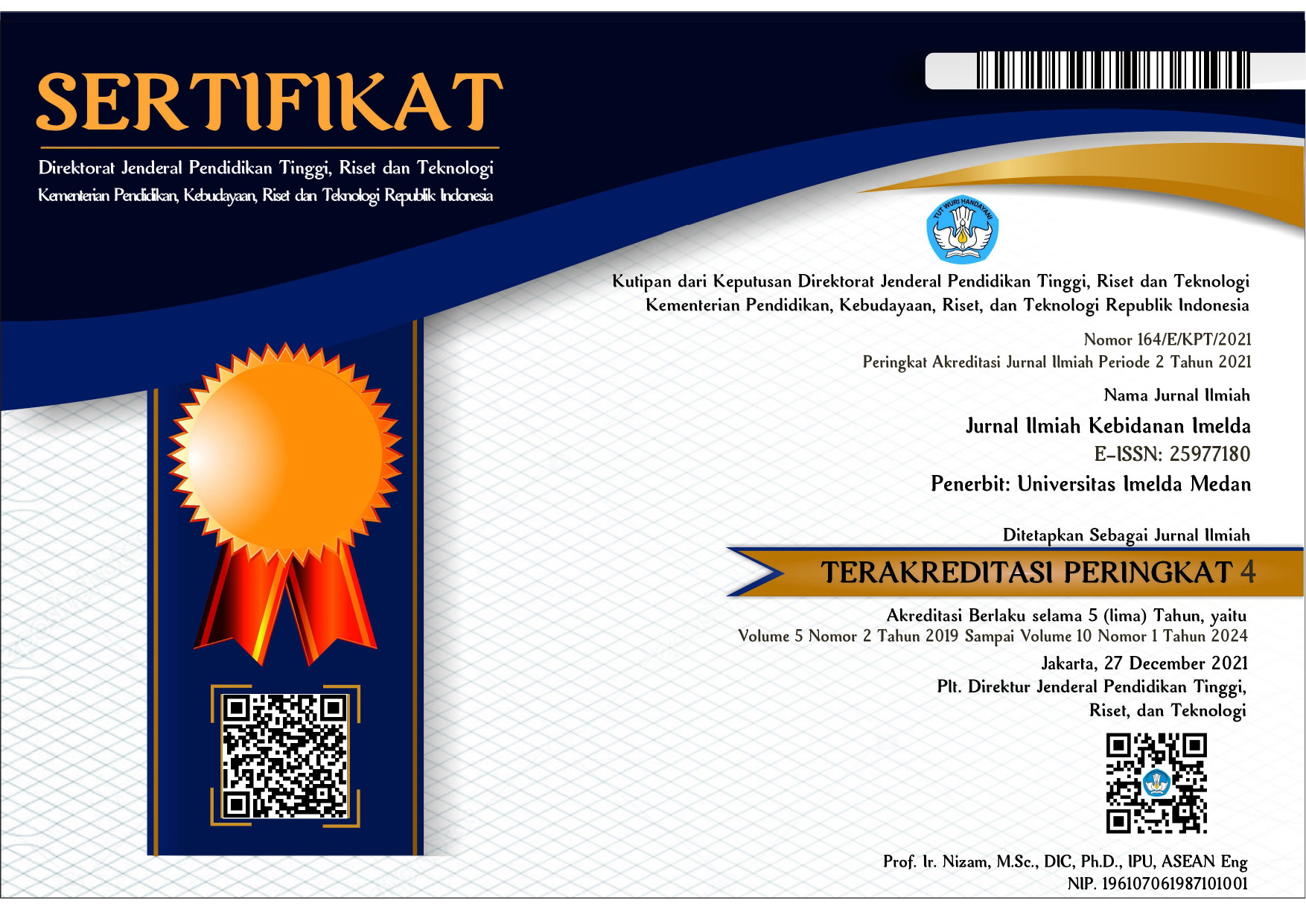HUBUNGAN PELAKSANAAN ROOMING IN PADA IBU NIFAS DENGAN PENINGKATAN FREKUENSI PEMBERIAN ASI DI RSU ROYAL PRIMA MEDAN TAHUN 2022
DOI:
https://doi.org/10.52943/jikebi.v9i1.1147Keywords:
Admission, Frequency of Breastfeeding, Postpartum MothersAbstract
Rooming in is a joint care between a newborn and his mother who is treated in one room in the same room for 24 full hours so that an early infant mother bonding process occurs immediately due to body touch between the baby and mother (Paninsari, 2020). The research method used is cross sectional. The purpose of the study was to determine the relationship between the implementation of rooming in postpartum mothers with the increase in the frequency of breastfeeding at the RSU. Royal Prima Medan. The sample in this study were 30 respondents with purposive sampling technique. Collecting data using observation and questionnaires. The research was conducted from September to October. The results of the study were the majority of respondents aged 31-40 years were 20 people (66.7%), the minority respondents aged 19-30 years were 10 people (33.3%). And the majority of respondents with D3-S1 education are 17 (56.7%) people, while the minority have elementary-high school education as many as 13 (43.3%) respondents. The majority of respondents who gave birth to normal were 25 (83.3%) people, while the minority type of delivery was caesarean section as many as 5 (16.7) respondents. And the majority who did not carry out hospitalization were 16 (53.3%) while the minority who did hospitalization were 14 (46.7%) respondents. The majority of the frequency 8-12 times a day as many as 19 (63.3%) respondents and the minority of the frequency of breastfeeding 2-6 times a day as many as 11 (36.7) respondents. Data analysis using Chi square results obtained by the value of value = 0.000, with a value of value < (0.05). Conclusion There is a significant relationship between rooming in and an increase in the frequency of breastfeeding for postpartum mothers at the Royal Prima Hospital in Medan.
References
D. Paninsari, “Penyuluhan Manfaat Rawat Gabung Dengan Kelnacaran Produksi ASI Pada Ibu di Desa Amplas,” J. unprimdn, vol. 1, no. 1, 2020.
Nurhidayati, S. Saleha, Z. Hanum, and Agustina, “Edukasi Pemberian Asi Eksklusif Pada Ibu Yang Memiliki Bayi Usia 0-6 Bulan Di Masa Pandemi Covid-19 Di Desa Paya Meuneng Kecamatan Peusengan Kabupaten Bireuen Tahun 2021,” JPKM J. Pengabdi. Kpd. Masy., vol. 3, no. 2, 2021, [Online]. Available: https://jurnal.uui.ac.id/index.php/jpkmk/article/view/1702
I. Sari and R. Mayasari, “Hubungan Tingkat Pengetahuan Ibu Mengenai Rooming In Terhadap Kelancaran Produksi ASI,” J. Kebidanan J. Med. Sci. Ilmu Kesehat. Akad. Kebidanan Budi Mulia Palembang, vol. 11, no. 2, 2021, [Online]. Available: http://download.garuda.kemdikbud.go.id/article.php?article=2391949&val=15487&title=Hubungan Tingkat Pengetahuan Ibu Mengenai Pengaruh RoomingIn Terhadap Kelancaran Produksi ASI.
R. Manullang, F. S. Dewi, and M. Wulan, “Analisis Pelaksanaan Rooming In dengan kelancaran produksi ASI Pada Ibu Post SC (Sectio Caesarea) di Rumah sakit Sejati Mitra Medan Tahun 2020,” J. Heal. Technol. Med., vol. 8, no. 1, 2022.
Kementerian Kesehatan Republik Indonesia, Profil Kesehatan Indonesia Tahun 2020. Jakarta: Kementrian Kesehatan Republik Indonesia, 2021.
E. Ridwan and D. Capriani, “Hubungan Rawat Gabung Dengan Puskesmas Wara Barat Kota Palopo,” Madu J. Kesehat., vol. 9, no. 1, 2020.
S. Notoadmodjo, Metodologi Penelitian Kesehatan. Jakarta: PT. Rineka Cipta Jakarta, 2018.
Musafa’ah, S. R. D.A, and A. H. Kholis, “Hubungan Rawat Gabung Dengan Produksi Asi Pada Ibu Nifas Di Ruang Melati Rsud Kabupaten Jombang,” J. Stikes Pemkab Jombang, vol. 3, no. 2, 2017, [Online]. Available: https://journal.stikespemkabjombang.ac.id/index.php/jikep/article/download/108/104
D. Hasriyana and E. Surani, “Pentingnya Memberikan Asi Ekslusif Untuk Kehidupan Bayi Dalam Perspektif Islam dan Kesehatan,” vol. 8, no. 5, 2021.
W. Pertiwi and Anjarwati, “Hubungan Pelaksanaan Rawat Gabung Dengan Frekuensi Menyusui Pada Ibu Post Partum Di RSKIA Sleman Yogyakarta,” STIKES Aisyiyiyah Yogyakarta, 2010.










